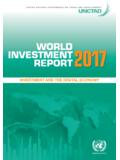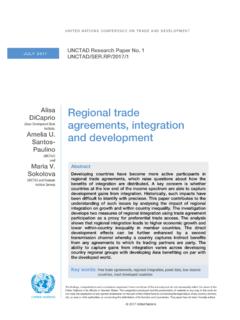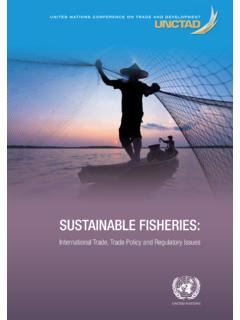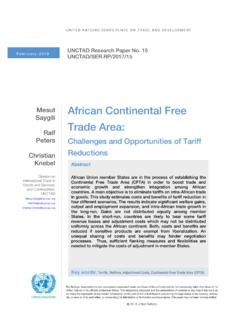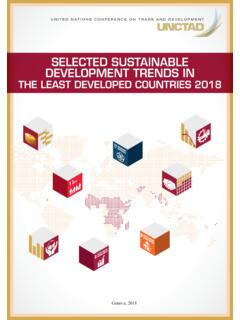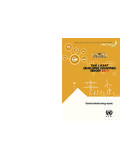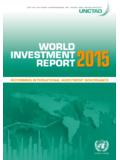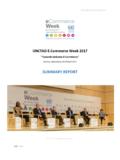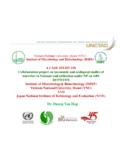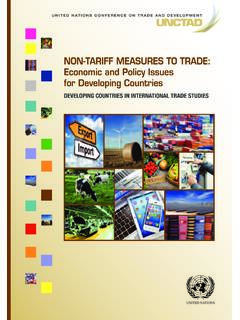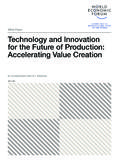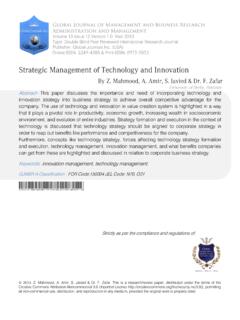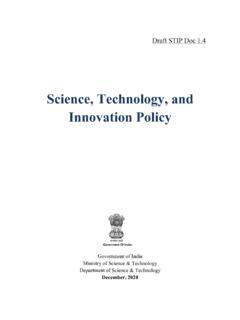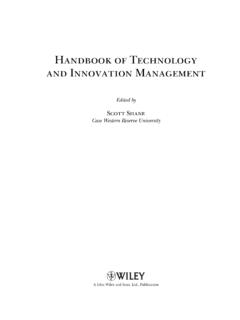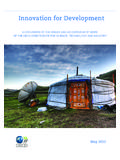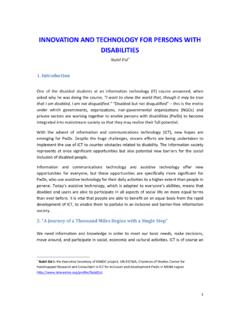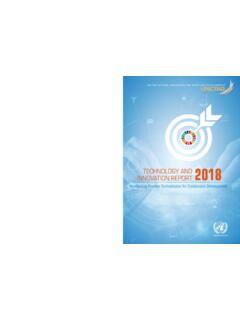Transcription of Technology and Innovation Report 2021 - UNCTAD
1 UNITED NATIONS CONFERENCE ON TRADE AND DEVELOPMENTTECHNOLOGY AND Innovation REPORT2021 Catching technological wavesInnovation with equity Geneva, 2021 Technology AND Innovation Report 2021ii 2021, United NationsAll rights reserved worldwideRequests to reproduce excerpts or to photocopy should be addressed to the Copyright Clearance Center at other queries on rights and licences, including subsidiary rights, should be addressed to: United Nations Publications405 East 42nd StreetNew York, New York 10017 United States of AmericaEmail: designations employed and the presentation of material on any map in this work do not imply the expression of any opinion whatsoever on the part of the United Nations concerning the legal status of any country, territory, city or area or of its authorities, or concerning the delimitation of its frontiers or publication has been edited externally.
2 United Nations publication issued by the United Nations Conference on Trade and : 978-92-1-113012-6eISBN: 978-92-1-005658-8 ISSN: 2076-2917eISSN: 2224-882 XSales No. AND Innovation Report 2021iiiCATCHING TECHNOLOGICAL WAVESI nnovation with equity NOTEW ithin the UNCTAD Division on Technology and Logistics, the STI Policy Section carries out policy-oriented analytical work on the impact of Innovation and new and emerging technologies on sustainable development, with a particular focus on the opportunities and challenges for developing countries. It is responsible for the Technology and Innovation Report , which seeks to address issues in science, Technology and Innovation that are topical and important for developing countries, and to do so in a comprehensive way with an emphasis on policy-relevant analysis and conclusions.
3 The STI Policy Section supports the integration of STI in national development strategies and in building up STI policy-making capacity in developing countries; a major instrument in this area is the programme of Science, Technology and Innovation Policy Reviews. The section also serves as the core secretariat of the United Nations Commission on Science and Technology for Development (CSTD).In this Report , the terms country/economy refer, as appropriate, to territories or areas. The designations of country groups are intended solely for statistical or analytical convenience and do not necessarily express a judgement about the stage of development reached by a particular country or area in the development process. Unless otherwise indicated, the major country groupings used in this Report follow the classification of the United Nations Statistical Office.
4 These are:Developed countries: the member countries of the Organisation for Economic Co-operation and Development (OECD) (other than Chile, Mexico, the Republic of Korea and Turkey), plus the European Union member countries that are not OECD members (Bulgaria, Croatia, Cyprus, Lithuania, Malta and Romania), plus Andorra, Liechtenstein, Monaco and San Marino. Countries with economies in transition refers to those of South-East Europe and the Commonwealth of Independent States. Developing economies, in general, are all the economies that are not specified above. For statistical purposes, the data for China do not include those for the Hong Kong Special Administrative Region of China (Hong Kong, China), Macao Special Administrative Region of China (Macao, China) or Taiwan Province of China.
5 An Excel file with the main country groupings used can be downloaded from UNCTAD stat at: to sub-Saharan Africa include South Africa unless otherwise in the text to the United States are to the United States of America and those to the United Kingdom are to the United Kingdom of Great Britain and Northern term dollar ($) refers to United States dollar, unless otherwise term billion signifies 1,000 rates of growth and change refer to compound of a dash ( ) between dates representing years, such as 1988 1990, signifies the full period involved, including the initial and final oblique stroke (/) between two years, such as 2000/01, signifies a fiscal or crop dot (.) in a table indicates that the item is not dots (.)
6 In a table indicate that the data are not available, or are not separately dash ( ) or a zero (0) in a table indicates that the amount is nil or and percentages do not necessarily add up to totals because of AND Innovation Report 2021ivCATCHING TECHNOLOGICAL WAVESI nnovation with equity FOREWORDR ecent developments in frontier technologies, including artificial intelligence, robotics and biotechnology, have shown tremendous potential for sustainable development. Yet, they also risk increasing inequalities by exacerbating and creating new digital divides between the Technology haves and have-nots. The COVID-19 pandemic has further exposed this dichotomy. Technology has been a critical tool for addressing the spread of the disease, but not everyone has equal access to the benefits.
7 It is time to ask how we can take full profit from the current technological revolution to reduce gaps that hold back truly inclusive and sustainable development. The UNCTAD Technology and Innovation Report 2021 examines the likelihood of frontier technologies widening existing inequalities and creating new ones. It also addresses the national and international policies, instruments and institutional reforms that are needed to create a more equal world of opportunity for all, leaving no one behind. The Report shows that frontier technologies already represent a $350 billion market, which could grow to $ trillion by 2025. This offers great opportunities for those ready to catch this technological wave.
8 But many countries, especially the least developed and those in sub-Saharan Africa, are unprepared to equitably use, adopt and adapt to the ongoing technological revolution. This could have serious implications for achieving the Sustainable Development Goals. The Technology and Innovation Report 2021 urges all developing nations to prepare for a period of deep and rapid technological change that will profoundly affect markets and societies. All countries will need to pursue science, Technology and Innovation policies appropriate to their development stage and economic, social and environmental conditions. This requires strengthening and aligning Science, Technology and Innovation systems and industrial policies, building digital skills among students and the workforce, and closing digital divides.
9 Governments should also enhance social protection and ease workforce transitions to deal with the potential negative consequences of frontier technologies on the job market. The Report also calls for strengthened international cooperation to build Innovation capacities in developing countries, facilitate Technology transfer, increase women s participation in digital sectors, conduct technological assessments and promote an inclusive debate on the impact of frontier technologies on sustainable development. A key takeaway from the Report is that technologies are not deterministic. We can harness their potential for the common good, and we have an obligation to do so. That is why I launched a Strategy on New Technologies in September 2018 to guide the United Nations system on how new technologies can and must be used to accelerate the achievement of the Sustainable Development Goals and the realization of the promise of the United Nations Charter and the Universal Declaration of Human Rights.
10 New technologies hold the promise of the future, from climate action and better health to more democratic and inclusive societies. As this Report highlights, the guiding principle of the 2030 Agenda for Sustainable Development to leave no one behind provides a compelling incentive for harnessing frontier technologies for sustainable development. Let us use them wisely, for the benefit of nio GuterresSecretary-GeneralUnited NationsTECHNOLOGY AND Innovation Report 2021vCATCHING TECHNOLOGICAL WAVESI nnovation with equity PREFACEThe Technology and Innovation Report 2021 critically examines the possibility of frontier technologies such as AI, robotics and gene-editing widening existing inequalities and creating new ones.
